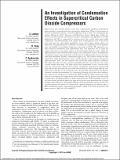| dc.contributor.author | Lettieri, Claudio | |
| dc.contributor.author | Yang, David | |
| dc.contributor.author | Spakovszky, Zoltan S | |
| dc.date.accessioned | 2018-07-20T17:19:57Z | |
| dc.date.available | 2018-07-20T17:19:57Z | |
| dc.date.issued | 2015-02 | |
| dc.date.submitted | 2014-10 | |
| dc.identifier.issn | 0742-4795 | |
| dc.identifier.uri | http://hdl.handle.net/1721.1/117029 | |
| dc.description.abstract | Supercritical CO[subscript 2](S-CO[subscript 2]) power cycles have demonstrated significant performance improvements in concentrated solar and nuclear applications. These cycles promise an increase in thermal-to-electric conversion efficiency of up to 50% over conventional gas turbines (Wright, S., 2012, "Overview of S-CO[subscript 2] Power Cycles," Mech. Eng., 134(1), pp. 40-43), and have become a priority for research, development, and deployment. In these applications the CO[subscript 2] is compressed to pressures above the critical value using radial compressors. The thermodynamic state change of the working fluid is close to the critical point and near the vapor-liquid equilibrium region where phase change effects are important. This paper presents a systematic assessment of condensation on the performance and stability of centrifugal compressors operating in S-CO[subscript 2]. The approach combines numerical simulations with experimental tests. The objectives are to assess the relative importance of two-phase effects on the internal flow behavior and to define the implications for radial turbomachinery design. The condensation onset is investigated in a systematic manner approaching the critical point. A nondimensional criterion is established that determines whether condensation might occur. This criterion relates the time required for stable liquid droplets to form, which depends on the expansion through the vapor-pressure curve, and the residence time of the flow under saturated conditions. Two-phase flow effects can be considered negligible when the ratio of the two time scales is much smaller than unity. The study shows that condensation is not a concern away from the critical point. Numerical two-phase calculations supported by experimental data indicate that the timescale associated with nucleation is much longer than the residence time of the flow in the saturated region, leaving little opportunity for the fluid to condense. Pressure measurements in a converging diverging nozzle show that condensation cannot occur at the level of subcooling characteristic of radial compressors away from the critical point. The implications are not limited to S-CO[subscript 2] power cycles but extend to applications of radial machines for dense, saturated gases. In the immediate vicinity of the critical point, two-phase effects are expected to become more prominent due to longer residence times. However, the singular behavior of thermodynamic properties at the critical point prevents the numerical schemes from capturing important gas dynamic effects. These limitations require experimental assessment, which is the focus of ongoing and future research. | en_US |
| dc.description.sponsorship | Mitsubishi Heavy Industries Takasago R&D Center | en_US |
| dc.publisher | ASME International | en_US |
| dc.relation.isversionof | http://dx.doi.org/10.1115/1.4029577 | en_US |
| dc.rights | Article is made available in accordance with the publisher's policy and may be subject to US copyright law. Please refer to the publisher's site for terms of use. | en_US |
| dc.source | ASME | en_US |
| dc.title | An Investigation of Condensation Effects in Supercritical Carbon Dioxide Compressors | en_US |
| dc.type | Article | en_US |
| dc.identifier.citation | Lettieri, C., et al. “An Investigation of Condensation Effects in Supercritical Carbon Dioxide Compressors.” Journal of Engineering for Gas Turbines and Power, vol. 137, no. 8, Aug. 2015, p. 082602. © 2015 by ASME. | en_US |
| dc.contributor.department | Massachusetts Institute of Technology. Department of Aeronautics and Astronautics | en_US |
| dc.contributor.mitauthor | Lettieri, Claudio | |
| dc.contributor.mitauthor | Yang, David | |
| dc.contributor.mitauthor | Spakovszky, Zoltan S | |
| dc.relation.journal | Journal of Engineering for Gas Turbines and Power | en_US |
| dc.eprint.version | Final published version | en_US |
| dc.type.uri | http://purl.org/eprint/type/JournalArticle | en_US |
| eprint.status | http://purl.org/eprint/status/PeerReviewed | en_US |
| dc.date.updated | 2018-04-11T13:44:15Z | |
| dspace.orderedauthors | Lettieri, C.; Yang, D.; Spakovszky, Z. | en_US |
| dspace.embargo.terms | N | en_US |
| dc.identifier.orcid | https://orcid.org/0000-0003-2167-9860 | |
| mit.license | PUBLISHER_POLICY | en_US |
